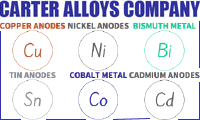
Curated with aloha by
Ted Mooney, P.E. RET

The authoritative public forum
for Metal Finishing 1989-2025

-----
Copper Plating
Q. Hi people, I'm plating copper alloy with copper using a high efficiency copper cyanide bath. Using copper anodes, we control the free cyanide at 3-4 oz/Gal, copper at 4-5 oz/Gal. The pH is around 13 with temp at 65 °C.
The problem is whenever I use copper alloy 7025, red spots can be seen on the surface. But none seen when I use different type copper alloy, e.g., Olin 194. Does anyone experience this situation? The current density range from 80 - 200 ASF.
I would be grateful if someone could explain what is causing this. Thanks.
- Malaysia
2000
A. Hi Deen. That current density is very high for traditional rack plating, which would probably be more like 30 ASF. I assume you have a fairly fancy agitation system which is propelling plating solution onto the surface to thin down the barrier layer and assure the presence of plenty of copper ions. I mention this because it's possible that high current density plating exhibits certain anomalies that might not be seen by platers operating at lower current densities.
I can't answer your question, I can only guess; but Alloy 7025 is quite different from Olin 194. For example, it contains about 3% nickel, and I suppose the nickel could migrate to specific spots on the surface and be passive. You may need to sample old alloy vs. fresh alloy, as received vs. freshly re-machined, etc. Sorry, but I think you have a tough problem on your hands.
Regards,

Ted Mooney, P.E.
Striving to live Aloha
finishing.com - Pine Beach, New Jersey
December 6, 2012
Q. Hello, I am in the need for info re: high purity copper plating over high purity copper piece (101 OFE - Outukumpuo's best). I need to equal the low oxygen and physical requirements. Thanks, Paul
Paul OlderrFermilab (DOE) - Batavia, Illinois
2000
Sorry I can't be of help here. I am very curious however, why someone would be interested in plating copper over copper?
W. Carl Erickson- Rome, New York
2000
Hi.
I'm designing line to through [hole?] plate. I've some materials but I need more. Can you give me any link to good description on this topic?
Best regards,
Electronics - Gdynia, Pomorskie, Poland
2004
adv.: Supplier of Copper Anodes, Nickel Anodes, Bismuth Metal, & Other Metal Products for Industry & The Arts

Q, A, or Comment on THIS thread -or- Start a NEW Thread